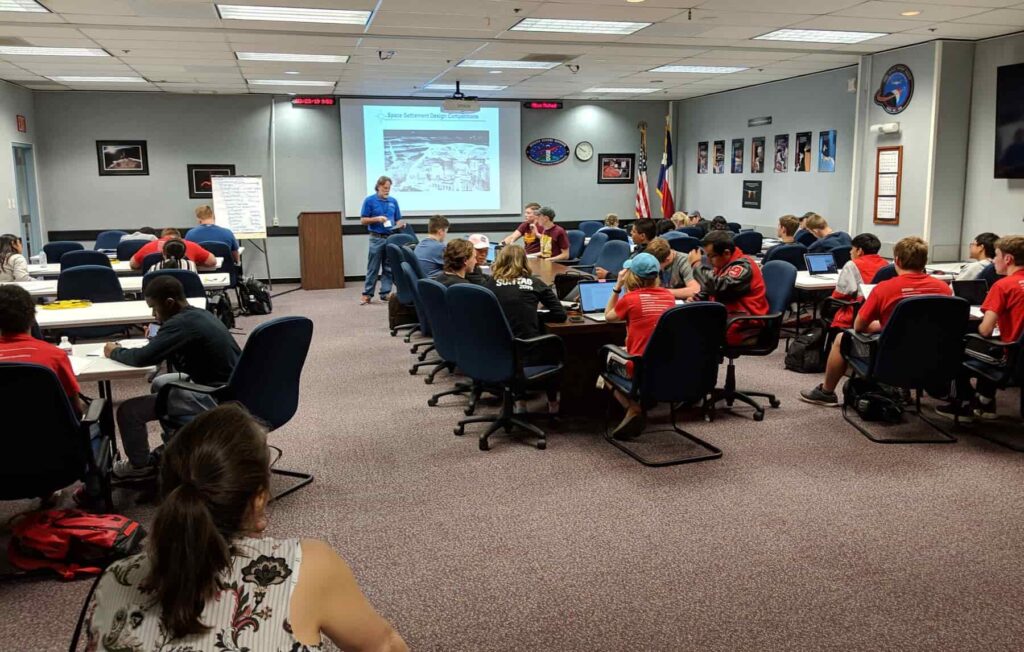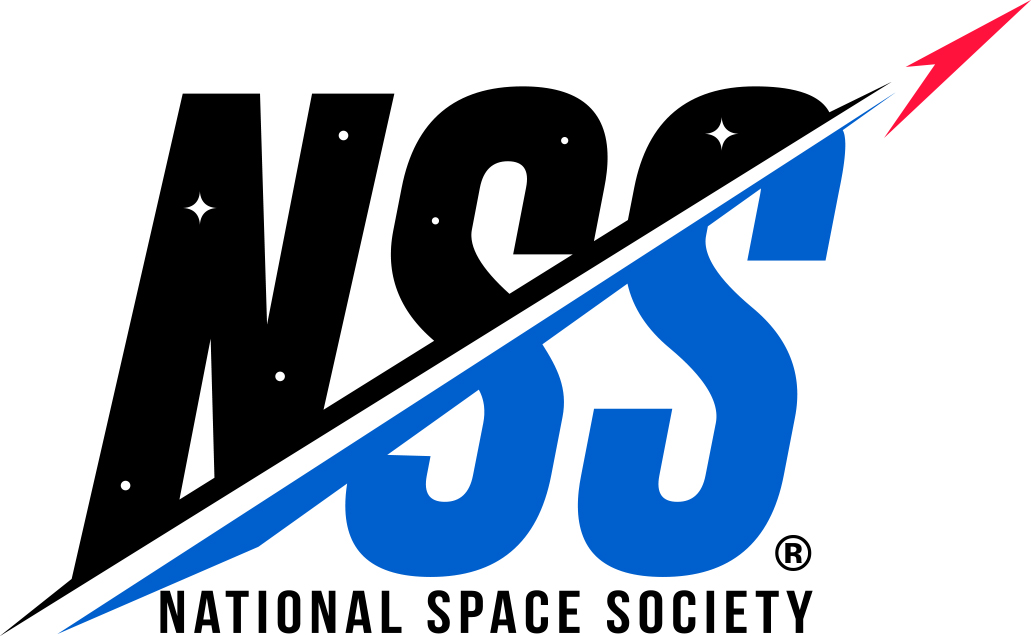Subcontractors
At space conferences where engineers discuss and show plans for future human activities in space, companies and individuals show results of analyses predicting economics, chemistry, and processing of extraterrestrial materials to produce commodities and services for use in space. SSDCs predict that Subcontractor companies will establish facilities to offer these standard resources, so that prime contractors can focus on designing to meet the unique requirements of each design. Some of the Subcontractors described for SSDCs are likely to exist for real—and entrepreneurial students can look at the list to get ideas for future businesses they may want to establish during their careers.
Setting up in space
Your students will work as prime contractors to complete a contract for the Foundation Society. Prime contractors are companies which have a broad skill set and are hired to complete work that the customer cannot do themselves. However, the very nature of establishing a human settlement in space is an incredibly difficult task. There are so many different things to consider and one company alone cannot provide everything to make a functional settlement. Moreover, your students do not have enough time to consider every facet of a space settlement.
A surprisingly good example of this is toilet paper; wherever your students are asked to set up a space settlement, humans are going to require toilet paper. Are you going to transport it from Earth to the settlement? Are you going to make it on the settlement? How and where are you going to get the material to make the toilet paper? These questions have very expensive answers. If a prime contractor has to spend thousands of hours and millions of dollars developing toilet paper for the Moon, it will not only hamper their proposal but also damage their company financially. The solution to this problem and many more are subcontractors.
What is a subcontractor?
Subcontractors are companies that offer specialized goods and services to any prime contractors that are willing to pay. Many of the goods and services they offer can be used to answer sections of the RFP. These solutions tend to reduce the cost and time it takes to establish the settlement. As a result, students can spend more time coming up with innovative and creative solutions to some of the more challenging RFP points. Furthermore, it is also possible for prime contractors to subcontract one another. There are only so many things you can do effectively as a company and utilizing subcontractors effectively demonstrates a great amount of engineering maturity. All these factors enable your students to come up with a proposal that answers the RFP and is feasible in the eyes of the Foundation Society.

Subcontractors List Example
The list of Subcontractors available to help with responding toSSDC RFPs from the Foundation Society changes for different scenarios; a subcontractors list will be provided for each year’s qualifying scenario. This list provides examples of the commodities and services that can be acquired from Subcontractors.
3D Logistics successfully 3D printed tools and components from a variety of feedstock materials, and now has a production facility at Alexandriat. The company developed a 3D printing system that is flown on spacecraft to enable using materials from failed parts as feedstock for replacement parts, eliminating most of the need for on-board logistics inventory.
Blown Away specializes in making inflatable buildings per customer specifications, to enable quick initial construction of new communities on the Moon or in orbit. Although these structures are not intended for permanent or indefinite use, they provide shelter for residents to start new economic activities, until more durable solutions can be established. The buildings are appropriate for long-term use in pressurized, thermal-controlled, and radiation-protected environments The company also has a product line of inflatable furniture, cheap to ship and simple to set up.
Bots4U offers purpose-built robots for home and office use. Currently available functions for robots are cleaning household surfaces, washing dishes, doing laundry, moving furniture, and fetching household items for their owners. The company offers to build robots to customer specifications for lunar applications; robots built for use on Earth perform poorly in 1/6 g.
Bottom Cleaners recognized a critical need for long-term space habitation, first discussed in public at an NSS Space Settlement Summit in 2017: toilet paper. A system adequate for continuously supplying toilet paper for 1000 people fits in one CASSSC, and can be installed anywhere in a pressurized volume where power and water service are provided. The facility makes toilet paper out of plant fibers collected from agricultural and landscaping waste. Excess capacity can be used for making paper towels and other household paper wiping / absorbing products.
Clean Up Your Act recycles water from cleaning, kitchens, and agriculture, and delivers potable water back into lunar communities’ safe water supply. The company also advises communities on maintenance of proper atmosphere composition, and provides air revitalization when CO2 or other atmosphere components go out of balance. The company has an agreement with Waste Products that it can install its infrastructure simultaneously with installation of sewer lines.
Custom Cargo Accommodations produces Cargo Accommodation in Standard Space ShippingContainer (CASSSC) units, compatible with standard interfaces in launch vehicles and interorbital spacecraft currently in use. CASSSCs are 30 feet (9.144 meters) long with nearly-square 15-foot (4.572 meters) cross-sections (corners of the cross-section are rounded with a 1-foot radius). Generic CASSSCs are aluminum, fully enclosed, and vented to permit pressure equalization. Special-order CASSSCs can be whatever customers choose within standard size and interface constraints, including pressurized, open framework, or made of composite materials.
Drone & Delivery provides small self-driving air and ground vehicles for use in pressurized volumes of space settlements and habitats. Applications of aerial drones are primarily transportation of small items and inspections in industrial and agricultural areas; small ground vehicles provide similar services in residential and commercial areas.
ElectroProtect builds components for circuits that can withstand space thermal and radiation environments, and shielding or protective boxes for components and circuits that cannot be built to withstand local environments.
Extreme Survival Technologies (EST) builds spacesuits, pressurized fabric impact protection systems (e.g., airbags and restraints), and portable emergency shelters. Its most popular products are hard-shell spacesuits customized for lunar operations but frequently used for other applications; efficiencies of assembly line production enable $400,000 unit costs.
Garden-A-Go-Go manufactures portable hydroponic and aeroponic eco-systems at Alexandriat for sustaining long-duration spaceship crews. The modules attach to the exterior of a ship, over an airlock that would normally go to vacuum; new inter-orbit spaceships are designed with appropriate interfaces. Sizes are available for crews of five, eight, or twelve, and special orders are cheerfully filled. Use of a Garden-A-Go-Go system requires that two crewmembers be trained to work the farm for one hour per day on average, mostly to harvest food for each day’s meals, cull dead matter, and check for pests and disease.
Hard Roll accepts ores from lunar mining operations, refines the metals, and produces rolled sheets, extruded beams, and custom shaped cast parts.
Holey Moley adapted designs of excavation equipment used on Earth, for use in 1/6 g on the lunar surface. It has created mining equipment, trench-diggers, backhoes, dirt-movers, graders, drills, and tunnelers, and will create new machines on request. Some types of applications require more than one design solution, depending on whether local conditions enable bracing the equipment to compensate for lack of gravity. The company founder says ”rocks on the Moon are just as hard as rocks on Earth, but my machines don’t have the same weight to punch through them”.
Litigation Limiters is a law firm that created a niche market which virtually eliminates conflict-of-interest suits for its clients, who usually are companies competing for the same contracts but in need of each others’ products and/or services. Litigation Limiters arranges its own contracts between providers of products and services, and customers, then serves as a go-between to supply the products and services to the customers. The company has such agreements with all of the world’s diversified corporations that have significant product lines applicable to space development. Litigation Limiters charges a 2% fee on product or service value.
Nano Solutions was established at Alexandriat to commercialize production and marketing of nanobots after techniques were developed to grow them in zero g and vacuum. The company is constantly innovating new nanobot applications, and accepts challenges to design for custom uses. Programmed nanobots sell by the ounce at roughly ten times the cost of platinum; when delivered they resemble a fine powder the customer applies as a thin layer to the working surface. Service life is one to five Earth years, depending on operating environment and application. The company reprograms nanobots for new tasks (compatible with their original application) for a modest fee.
OrbitLink Communications was established when the Alexandriat Space Settlement was under construction, to augment traditional communications channels. It subsequently developed standard equipment adaptable to any habitable space installation. The company has made arrangements to place one of its antennas and dedicated fiber optics links on every Foundation Society settlement.
Soil Solutions converts lunar and asteroidal dirt to non-abrasive soil for agriculture and landscaping. Products are delivered in CASSSCs, which must be unloaded in a thermally benign and pressurized environment to preserve the biota in the soil.
Stuff of Life has developed processes at Alaskol to make air and water from lunar materials. Air and water are shipped in sealed CASSSCs; air can be liquefied to reduce volume for shipping. The company intends to be the primary supplier of air and water as the human economy expands in the solar system.
Toss It To Me has developed processes for recycling trash and garbage from lunar habitations. What it receives is diverse and variable; the company President says “what we do is almost like alchemy, and most of what we recover to sell is byproducts”. Current processes manage to repurpose about 50% of input; a goal is to send no more than 10% to landfill. Each customer must allocate an interior area equivalent to 1% of the residential community’s land area for a building where conversion processes occur, a similar area outside the settlement for an unpressurized structure, and a third area as a landfill.
Waste Products has developed toilets and sewage handling systems that work in reduced gravity, and convert human waste to recycled water, excellent fertilizer rich in phosphorus, and a source of carbon. The systems do require that users decide before each sitting whether they will do “#1” or “#2”. The company works with developers of new lunar habitations to design and install sewer systems; it requires uninhibited access to each building site for 100 homes for one month after the site is graded and prepared for construction.
Wheels of Fortune builds vehicles at Bellevistat for lunar exploration and long-distance cargo hauling. Exploration vehicles can operate for up to three months away from civilization with a crew of six. Cargo hauling vehicles can operate autonomously (driverless) on lunar roads equipped with navigation aids, and can tow trains of up to ten trailers, each trailer supporting one filled CASSSC. Both types of vehicles are shipped in CASSSCs; an exploration vehicle completely fills a CASSSC, two tow vehicles can fit in one CASSSC, and six trailers can fit in one CASSSC.
ZAP! Industries is the leading supplier of wire harnesses for distribution of electrical power, and fiber optics systems for electronic signals on spacecraft. The company operates a system for zero-g manufacturing of solar cells from materials available in silicate asteroids. ZAP! sells each of these units for $40 million, not including transportation to deposit it on an appropriate asteroid, where it produces 1 x 2 foot solar panels at the rate of 1,000 per day, each of which is capable of generating 38 watts of power in Earth orbit and weighs 2 pounds, at a cost of $80 per kW (not including transportation to the user site).

